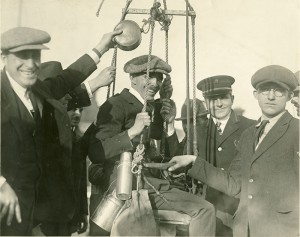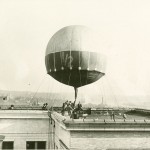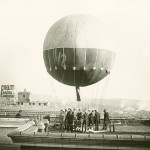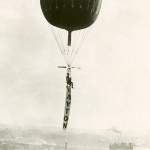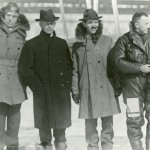Levitt Luzern Custer was a Dayton-area aviator and inventor, and an associate of Orville Wright. During his lifetime he engaged in pioneering balloon experiments, served as an official timer for flight trials, collaborated with Orville Wright on various projects, and invented a wide range of mechanical machines from the statoscope to amusement park rides.
The following is the first in a two-part blog series written by WSU Public History student Emily McAlhany, as part of a class project.
*****
“You can fly a barn door if you’ve got enough power.”
-L. Luzern Custer, 1961
Levitt Luzern Custer was born in Dayton, Ohio, on July 27, 1888, to Levitt Ellsworth and Effie Jane (Zimmerman) Custer. Luzern’s father, Ellsworth, was a well-known Dayton dentist and balloonist. He invented the first electric oven for annealing gold crowns and authored a book on dental electricity published in 1901.
Luzern attended the schools in Dayton, and he graduated from Steele High School. He was a close friend of the Wright Brothers, though he was closer to Orville than he was to Wilbur.
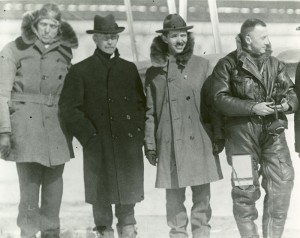
L-R: Al Johnson, Orville Wright, L. L. Custer, and John Macready, at Macready’s World Altitude Record, Sept. 5, 1924
Luzern went on to get his Bachelor of Science degree from Otterbein College in 1910 and his Master of Science from Massachusetts Institute of Technology (MIT) in 1913.
After Luzern graduated from MIT, he went to work at the National Cash Register Company as a research engineer. While he was at home, he went to the shed behind the house to work on some inventions.
In 1916, Luzern opened his own company, the Custer Specialty Company, which made and sold all of Luzern’s inventions (more on those in Part 2). The factory building was four stories and had a mini golf course on one floor and large fish tanks on another. At some point a large red arrow was painted on top of the building pointing toward McCook’s Field. The company was known both nationally and internationally. They shipped to England, Venezuela, Guatemala, and other European and South American countries. After Luzern died, his wife Gladys continued running the company for four and half years before it burned down.
In addition to inventing things, Luzern liked to balloon; he got that from his father. His first ascent with the balloon was in 1909; later on, in 1923, he jumped of the Reibold Building with a balloon and landed in Middletown. That was a long jump!
Luzern also enjoyed photography and travel. He went on several trips with Gladys, and he gave talks to groups of people on some of his trips from 1947-1960.
He was a member in the following clubs and organizations: Arabic, Engineers, Early Birds (an organization for people who flew before 1916), National Aeronautical Association, National Association of Amusement Parks, Executive, Discussion, American Representative of Federation Aeronautic International, and the official timer of the National Aeronautic Association. In 1961, the Early Birds awarded him the Bronze Plaque for his many years as an aviator enthusiast.
After a long life of inventing and traveling, L. Luzern Custer died August 30, 1962. He is buried in Woodland Cemetery in Dayton, Ohio. He had three sons: Randall, James, and Donald.
- Custer (center), Flight off the Reibold Building, Dayton, OH, May 2, 1923
- Flight off the Reibold Building, Dayton, OH, May 2, 1923
- Flight off the Reibold Building, Dayton, OH, May 2, 1923
- Flight off the Reibold Building, Dayton, OH, May 2, 1923
- L-R: Al Johnson, Orville Wright, L. L. Custer, and John Macready, at Macready’s World Altitude Record, Sept. 5, 1924
- Flight off the Reibold Building, Dayton, OH, May 2, 1923
The Levitt Luzern Custer Papers (MS-302) were donated to Wright State University Special Collections & Archives in August 2000 by Luzern’s son James.

